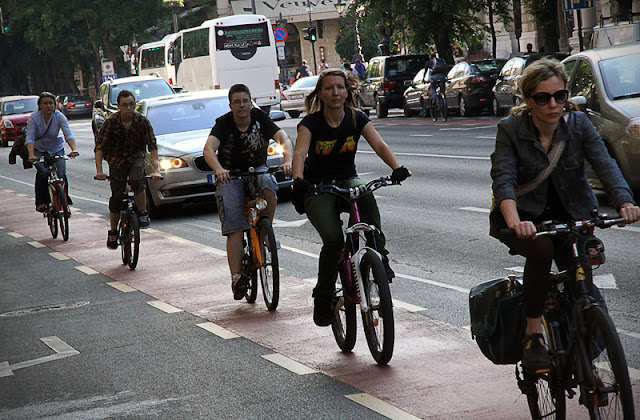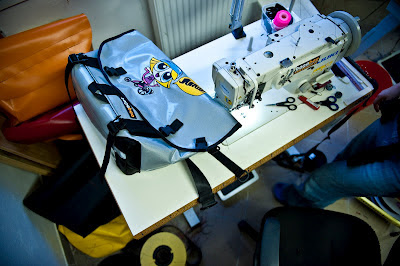 |
| Critical Mass, shortly after it was called off the first time. |
Everyone must know by now, but for posterity's sake I'll note it here anyway: the fall 2012 Critical Mass has been cancelled, and, according to organisers, they'll hold just one more ride next year before the CM closes for good.
The organisers, Károly Sinka and Gábor Kürti, head honchos of bike couriers
Hajtas Pajtas, have been publicly mulling a shut-down since
spring of last year. Since then, three more CMs transpired with little said about when they'd make good on their threat. As noted, one more CM is already planned, for spring of 2013, and in Sinya's and Kuku's follow-up comments on the Web, they do not rule out "reunion tours" in the future. So if this is really goodbye, it's shaping up to be a long one (and a quintessentially Hungarian one, too. According to local custom, social events never end abruptly. Guests typically take a half hour or longer between announcing their departure and actually departing. "Lassan megyünk," they say: "
We're leaving slowly.").
That said, it DOES sound like the organisers are more resolved this time. In the
the announcement at criticalmass.hu and in a follow-up
interview on the kerekagy blog, Sinya and Kuku said the ride had run its course. They noted that during the early years, CM could rightly take credit for the rising levels of everyday cyclists in Budapest. At one point, according to their surveys, nine of 10 cyclists on Budapest streets credited CM for getting them in the saddle. By now, the statistic has flipped: just one in 10 credits CM, with the rest riding for various other reasons.
A major point the two activists make is that CM has become a distraction from the more important work of professional lobbying, in particular, that done by the Hungarian Cyclists Club (
Magyar Kerékpárosklub - MK). The two view CM first and foremost as a lobbying tool, and while Critical Mass and the cycling club were once an effective double act -- CM lending the brawn, MK the brains -- it's no longer so, they say. With so many cyclists on the streets everyday of the week, CM has become redundant. "Now voters are already bicycling," Sinya said in the kerekagy piece. "Cycling is no longer a subculture."
The two believe that CM even undermines the bike club. Riders can join a free-of-charge Critical Mass once or twice a year and feel they've done their bit to advance cycling. But Kuku and Sinya say the most fruitful bike lobbying is done by MK, and MK needs money -- desperately. The club has teetered at the edge of insolvency for two years, as EU project opportunities dry up and contract payments get held up. One of the club's most popular initiatives -- the Bike to Work campaign (
Bringazz a Munkaba -- Bam) -- lost a significant subsidy from the Hungarian government a year ago or so. Financial stability requires a bigger base of individual memberships, they say: The current pool of 1,500 is just half of what's needed.
---
For myself, I completely respect the organisers' wish to direct their energies elsewhere. And there's no doubt that CM Budapest is past its prime. Participation peaked out more than four years ago. The numbers these days are still very respectable, but we can expect them to slide. Why not quit before they do?
I also agree that the cycling club needs all the support it can get. Yet I wonder how canceling CM will help. The average CM participant, I believe, comes out for a good time and to rub elbows with fellow enthusiasts. Buying a cycling club membership is not going to satisfy that social itch.
It's my personal view that CM should be handed over to a new organisation, one that would develop it into a festival. In recent years, this is how CM has been trending anyway -- with the after parties sponsored by the Dutch Embassy, the free classical concert last fall, and the several fashion show side events by Hungarian Cycle Chic, etc. CM -- or CM's successor -- could be further developed with more attractions, commercial sponsorships, a professional fund-raising drive and so on.
In fact, Sinya and Kuku have considered this same sort of handover, but they're not very convinced. In the kerekagy piece, Sinya remarked that he had attended a similar sort of event in Berlin, but didn't see it as a model to follow. "There wasn't a problem with it, but with such an event, nothing can be achieved," he said.
Nonetheless, I assume there's a big constituency that would like to give it a go. There are many models to follow. Besides the one in Berlin, there is the American
Tour de Fat, for example. This is a series of cycling events in several different cities sponsored by the New Belgium Brewing company (makers of Fat Tire ales). Tour de Fat events include a cycling parade (like CM), concerts, cycling competitions and exhibitions and more. The Tour de Fat in San Franciso is probably typical: it's organised and staffed by volunteers from the local cycling coalition and it attracts about 6,500 people. All proceeds from beer sales (the beer supplied for free by the sponsor) go to charity. Admission is free, though participants can give a voluntary contribution of USD 5 (about HUF 1,000) to the cycling coalition.
This sort of event could be organised relatively easily in Budapest. The community, the know-how, and the tradition of CM are already established. With a fresh perspective and new energy, this could just be what the CM community needs after eight years of serious demonstrating..







































